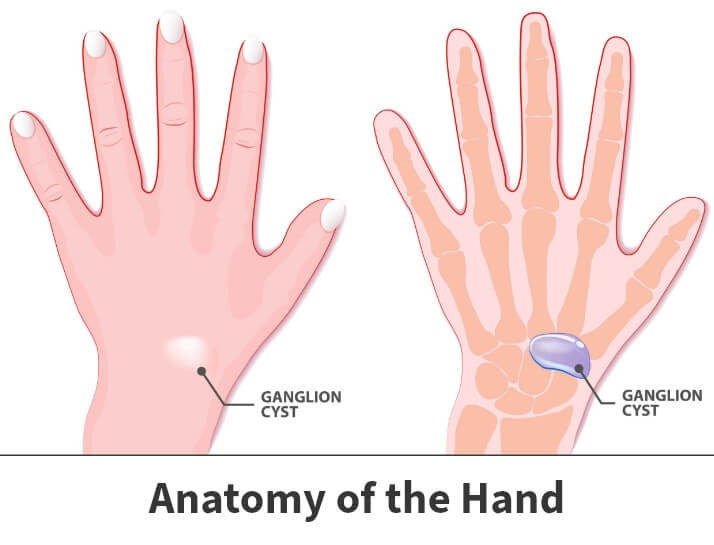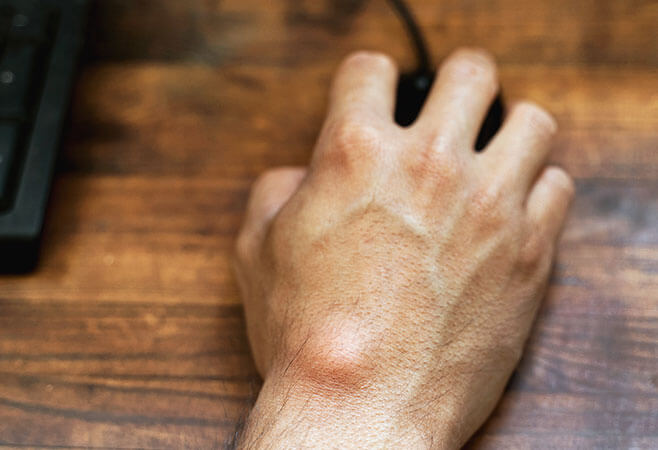Wrist ganglion cysts
Ganglion cysts, also called bible cysts, are non-harmful (benign) lumps on the hand. They are not cancerous and, in most cases, completely harmless. They can occur in various locations but most often appear on the wrist and hand. They can come out of nowhere and can disappear just as quickly. If the ganglion cyst pops up near a nerve, it can cause severe pain. If the cyst is not near the nerve, it may not cause pain. There are both surgical and nonsurgical treatment options available. Nonsurgical treatment options will always be recommended first, followed by surgical treatments if nothing else works.
Anatomy

Ganglion cysts are most commonly a mass or lump on the hand. They are not cancerous and, in most cases, completely harmless. A ganglion rises out of a joint, like a balloon. It grows out of the tissues, specifically the ligaments and joint linings surrounding a joint. Inside the cyst, there is a thick, slippery fluid.
About
Ganglion cysts most commonly develop in the wrists and hands. They vary in size and can get bigger with increased wrist activity. With rest, these cysts will typically become smaller.
Although the causes of ganglion cysts are unknown, we do know they are most common in younger people, typically between the ages of 15 and 40. Additionally, women are more likely to be affected than men. These cysts are also common among people who do rigorous activities that apply stress to the wrist, such as gymnasts.
Ganglion cysts that develop at the end joint of a finger — also known as mucous cysts — are typically associated with arthritis in the finger joint and are more common in women between 40 and 70.

Symptoms
Most ganglion cysts will form a visible lump. Smaller ganglion cysts can remain hidden under the skin. These types of ganglion cysts are known as occult ganglions.
Ganglion cysts usually are round or oval and form around joints or soft tissues. In most instances, these formations are pea-sized. They can grow larger as time progresses.
Ganglion cysts do not always cause pain, but many cases do produce some degree of discomfort. The most painful examples are those where growths emerge near nerves or other sensitive physical features. Aside from pain, they can cause swelling, tingling, numbness, weakness, and tenderness to the touch. More severe cases can lead to mobility limitations.
Ganglion cyst symptoms:
- A visible lump
- Pain
- Tingling
- Muscle weakness
- Some degree of discomfort
- Swelling
- Numbness
- Tenderness to touch
- Mobility limitations (in severe cases)
Causes
Researchers have not yet been able to pinpoint one specific underlying cause. Certain factors may trigger the condition. One theory is that ganglion cysts result from significant hand trauma impacting joints and soft tissues like ligaments and tendons. Ganglion cysts may be caused by structural flaws in tissues surrounding where cysts eventually develop.
Risk factors
One’s risk of contracting ganglion cysts is influenced by issues such as:
- Age – The problem occurs most often in younger persons between 15 and 40.
- Gender – Growths are seen far more frequently in women than men.
- Underlying Medical Conditions: Those stricken with joint ailments like arthritis stand at greater risk of developing ganglion cysts. This is especially true in women aged 40 to 70.
- Preexisting injuries – Individuals who have sustained joint or soft tissue injuries are more likely to develop cysts. In fact, a particular category of ganglion-related growths emerging from such causes is labeled mucous cysts. These formations appear on a finger’s nail side.
- Recreational activities – Ganglion cysts afflict persons competing in sports or other recreational activities where great stress is placed on the hands and wrists. A large percentage of cases impact gymnasts.
Diagnosis
Your Florida Orthopaedic Institute physician will look at your symptoms and overall medical history. They will also ask you how long you have had the ganglion cyst, whether it changes in size, and whether it is painful.
Your physician may also order some tests to confirm for diagnosis. These tests include:
- X-rays – These tests create clear pictures of dense structures, such as bone. Although X-rays will not show a ganglion cyst, they can be used to rule out other conditions that may be causing your symptoms.
- Magnetic resonance imaging (MRI) scans or ultrasounds – These imaging tests will show soft tissues, such as a ganglion cyst.
Treatment
Many ganglion cysts do not need treatment. But if the cyst is painful, interferes with function, or has an unacceptable appearance, several ganglion cyst wrist treatment options are available. There are both surgical and nonsurgical treatment options available. Nonsurgical treatment options would be recommended, followed by surgical treatments if other approaches do not work.
Nonsurgical treatments
There are two main steps to treating a ganglion cyst. These steps are:
- Immobilization – Activity often causes the ganglion to increase in size. It can also increase pressure on the nerves. Your physician may prescribe a brace or splint to help keep pressure off the cyst.
- Aspiration – If the ganglion causes severe pain or limits activities, the fluid can be drained from it to help reduce symptoms. This process is known as aspiration. Aspiration frequently fails to eliminate the ganglion because the “root” or connection to the joint or tendon sheath is not removed. A ganglion can be like a weed that will grow back if the root is not removed. Often the ganglion cyst returns after an aspiration procedure.
Surgical treatments
If your symptoms are not relieved from nonsurgical treatments, your physician may recommend surgery.
Surgery involves removing the cyst and part of the affected joint capsule or tendon sheath, which is considered the root of the ganglion. Even after excision, there is a small chance the ganglion will return.
Potential complications
Untreated cysts may grow increasingly painful and unsightly. Failure to get a proper diagnosis and treatment increases your chance of developing potentially dangerous infections.
Ganglion cysts are sometimes invaded by bacteria that can cause abscesses. If this pus-filled formation bursts, these pathogens may enter the bloodstream, travel throughout the body, and pose life-threatening concerns requiring swift and aggressive therapy.
Recovery
Most people make a full recovery. Even without treatment, some formations disappear on their own without incident. Most diagnosed cases respond favorably to treatment.
Cases requiring surgical intervention also heal in relatively short order. Surgically removed cysts do not usually recur. When recurrences do occur, revision surgery can be performed.
Prevention
It is currently believed that ganglion cysts cannot be prevented because they are still unsure of exactly what triggers the formations.
Videos
Related specialties
- Basal Joint Surgery
- Carpal Tunnel Syndrome
- De Quervain's Tenosynovitis
- Dislocated Finger
- Distal Radius Fracture (Broken Wrist)
- Dupuytren’s Disease
- Flexor Tendonitis
- Fractured Fingers
- Functional Nerve Transfers of the Hand
- Hand & Finger Replantation
- Hand Nerve Decompression
- Hand Skin Grafts
- Nerve Pain
- Peripheral Nerve Surgery (Hand) Revision
- Revascularization of the Hand
- Rheumatoid Arthritis of the Hand
- Sports Wrist & Hand Injuries
- Sprained Wrist
- Sudden Acute Finger, Hand & Wrist Injuries
- Targeted Muscle Reinnervation (TMR)
- Tendon Transfers of the Hand
- Thumb Ulnar Collateral Ligament Injuries
- Trigger Finger
- Ulnar Neuritis
- WALANT (Wide Awake Local Anesthesia No Tourniquet)
- Wrist Arthroscopy
- Wrist Fractures
- Wrist Tendonitis
